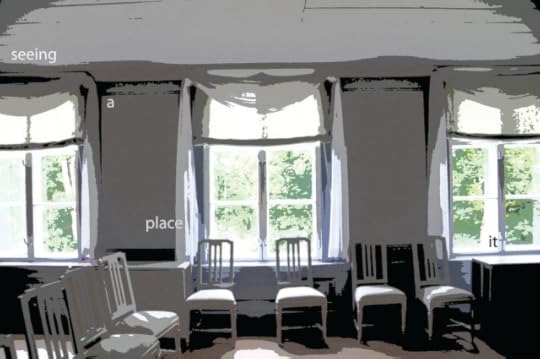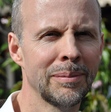In the Realm of Words and Vision

We see and, usually, think nothing of it. We are blind for most of our lives, for everything is invisible to us. We are both deaf and blind, and surrounded by mysteries we don't recognize. We pass through the world and see its bare outlines without recognizing the depth of it all, without moving our heads to just the right point so that we can see something that might change our lives. We don't realize we have to squat sometimes to see the world, or turn our heads or look down, or up. The world is a stew of sounds, yet we don't hear even the words spoken to us. We merely recognize their meanings as if no sounds were used to bring those meanings forth. We don't live. We merely exist. It all passes by us as if it didn't exist, so intent are we to get something (meaningless) done.
Then suddenly it changes, maybe only momentarily, and we are the kings and queens of the world because we can see what has been hiding before our eyes. For a second, only we know something beautiful. And we take it in. Then the car we are riding in proceeds forward, dumbly but dutifully, and we return to our lives, our existences, in the mute and formless world.
Maybe it is that poetry or maybe it is that the most we can extract from poetry or maybe it is that the best poetry can do for us is expose us to these heightened states of experience through the use of words. Poetry might be little more than a swift slap across the face, something to wake us out of our doldrums. And maybe it is that visual poetry does the same with the pieces of language, in their visible forms, and with images. And maybe it is that we know best how to live through our eyes.
Tonight, I'm thinking of my wife Nancy's (NF Huth's) newest chapbook, which arrived at the house today, and which is a simple piece of glory at the discovered mysteries of the world. This chapbook is part of the "this is visual poetry" chapbook series edited by Dan Waber, so it carries the title requires of every publication in that series: this is visual poetry. The series attempts to define the broad landscape of visual poetry by publishing a wide range of work from visual poets from across the globe.
And one of the many revelations from the series is that my wife is a visual poet. She comes at visual poetry from the world of the poet, from her poet's sensibilities, from a sense of the word and how it can say by being said and also by not being said. But she also comes at visual poetry as a photographer for she is always taking pictures, her eye is always seeing things I cannot see, and many of these are pictures that are both pointy and blue.
I barely noticed she was becoming a visual poet. She began by taking pictures, but these were all taken in the past. The vast majority of the pictures she took in 2009 at the Saari Residence in Mietoinen, Finland, but there are also pictures from Manchester (England, also 2009), and Caroga Lake and Schenectady in New York. These are simply pictures that caught her eye, and they are always still, motionless, photographs of objects for contemplation. No people appear in these photographs, no animals, no signs of movement, so no blurring, and they are made for us to see the world.
She began to sit on the couch over the winter and play with photographs on her iPad, and I had no idea what she was doing at first. Maybe she didn't either. She was distorting the photographs there, removing the details of contrast, flattening out variegations into solid bands of color, making the photographs more demandingly what they were objects of.
With the photographs carefully processed, with their colors regularized to soothing earth tones with surprising yet small areas of bright color, she began to place text upon these photographs. Very few words, but words suggesting a syntactic sequence. Words in colors to match the surroundings, and sometimes even to camouflage them, all done to force the reader to look, to slow down, to think. To see.
The words are simple and quiet and also uniform in certain ways. Each of these phrases—for each poem is made out of a single hollowed-out phrase—begins with a present participle (almost a gerund), ends with the pronoun "it," and somewhere within the phrase a word or words are missing. These pieces mean by saying and not saying, by leaving out, by leaving something unsaid, by making the reader write the poem. These are quiet, contemplative poems, and melancholy in spots. Yet fill the reader (speaking only for myself, the husband of the poet) with a sense of warmth, comfort, and this simmering joy at their beauty and deftness.
Spacing matters, too. She has placed the individual words in each phrase on the pages in such a way that we have to search for them and follow them, though they are not in a line. Take the cover poem, "seeing a place." The phrase begins top left with "seeing" sitting on the ceiling just above a wind. We move to the right and drop down, and there is an "a" in a corner where a window, a wall, and a ceiling meet. We drop down and move right and we see the word "place" on a wall between two windows, partially written on a curtain. Then there is a huge gap and we jump over a gap we must fill in before we reach "in" written in the bottom middle of a four-pane window. Chairs and windows are all around, and we are made to think of how this place is a holder of light and furniture and people, but also of words.
The words of the poem don't directly say anything, but they force thinking out of us. And they make us see, which is one of the best gifts a poem or a visual poem can be for us. You shouldn't believe me. I am the poet's husband. I cannot be trusted. I lie all the time. (I am a poet, after all.) But do you want to risk it? Can you live without its beauty? Would you want to even if you could survive?
This is one of the most effective books of visual poetry I've read, and one of the most accessible, even without ever giving us a complete phrase. These poems challenge us but they also draw us in and teach us how to read them. I want to read them again because I want to see them and I want to hear them and I want to discover what words I will slip into their beautifully milky voids.
_____
Huth, NF. this is visual poetry. chapbookpublisher.com: np, nd [2011]. US$10.
ecr. l'inf.
Published on April 01, 2011 20:14
No comments have been added yet.



